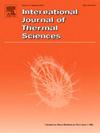Analytical calculation method for the thermal resistance of litz wires
IF 4.9
2区 工程技术
Q1 ENGINEERING, MECHANICAL
International Journal of Thermal Sciences
Pub Date : 2025-02-11
DOI:10.1016/j.ijthermalsci.2025.109754
引用次数: 0
Abstract
Compared to solid round wire, litz wire is widely used in high-frequency conditions to reduce winding losses, such as in high-frequency transformers or high-speed electric machines. However, the complex structure of the litz wire makes it challenging to accurately assess its thermal resistance. Existing methods ignore the effect of different heat sources on the radial thermal resistance and the impact of twisting structure on axial thermal resistance is rarely studied. In this paper, an analytical calculation method of litz-wire thermal resistance is presented, which considers the heat sources from outside and inside the litz wire respectively. The changes in heat transfer paths due to twisting structures in bundle or strand level are covered in the discussion of axial thermal resistance. Furthermore, differences in thermal resistance expressions caused by different fillings between strand interspace are derived. Finally, the proposed model is verified by comparing the measurement results of four different types of litz wires.
求助全文
约1分钟内获得全文
求助全文
来源期刊

International Journal of Thermal Sciences
工程技术-工程:机械
CiteScore
8.10
自引率
11.10%
发文量
531
审稿时长
55 days
期刊介绍:
The International Journal of Thermal Sciences is a journal devoted to the publication of fundamental studies on the physics of transfer processes in general, with an emphasis on thermal aspects and also applied research on various processes, energy systems and the environment. Articles are published in English and French, and are subject to peer review.
The fundamental subjects considered within the scope of the journal are:
* Heat and relevant mass transfer at all scales (nano, micro and macro) and in all types of material (heterogeneous, composites, biological,...) and fluid flow
* Forced, natural or mixed convection in reactive or non-reactive media
* Single or multi–phase fluid flow with or without phase change
* Near–and far–field radiative heat transfer
* Combined modes of heat transfer in complex systems (for example, plasmas, biological, geological,...)
* Multiscale modelling
The applied research topics include:
* Heat exchangers, heat pipes, cooling processes
* Transport phenomena taking place in industrial processes (chemical, food and agricultural, metallurgical, space and aeronautical, automobile industries)
* Nano–and micro–technology for energy, space, biosystems and devices
* Heat transport analysis in advanced systems
* Impact of energy–related processes on environment, and emerging energy systems
The study of thermophysical properties of materials and fluids, thermal measurement techniques, inverse methods, and the developments of experimental methods are within the scope of the International Journal of Thermal Sciences which also covers the modelling, and numerical methods applied to thermal transfer.
 求助内容:
求助内容: 应助结果提醒方式:
应助结果提醒方式:


